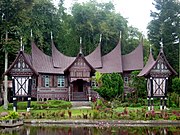Humlebæk, Denmark
June 7 through September 18, 2005
“Each new situation requires a new architecture.”
Jean Nouvel
Conceived as a manifesto of Nouvel’s thoughts and ideas about architecture, the exhibition challenges our sensory responses in order to understand how the fundamental architectural principle of a strong dialogue with the spirit and specific character of a place forms the point of departure for all his project.
Using the Louisiana Museum as a model example Nouvel visualized the discovery and experience of the place as film sequences mixed with his own story.

Photo: arcspace
The Manifesto Room takes the form of a purely textual space where the walls carry a whole succession of the statements, with related quotes, that make up the manifesto.
On the floor are large stacks of the exhibition catalogue in the form of a free newspaper and a poster, a visual atlas of a number of striking Nouvel projects, put together and edited by French writer and architecture critic Olivier Boissière.

Photo: arcspace
In the Portrait Gallery, a curving wall shows two long, continuous sequences linking sound and photography at various scale intervals.
On one wall twenty new architectural portraits of Nouvel’s projects from around the world, by architects and photographers Jorge Mestre and Ivan Bercedo from Mizien, on the opposite wall Nouvel’s timeline runs like a long bright ribbon with inlaid sounds in a sound scenography created especially for this room by Olivier Bardin.

photo: arcspace
In Dreams for the City the medium changes from the photographer interpreting architecture to that of the comic-strip artist.
Groups of French and Belgian comic-strip artists freely conjure up large urban scenarios dealing with Nouvel and his world.

Photo: arcspace
Ecole Súpérieure de l'Image, Angoulème, France

Photo: arcspace
"5'ième couche", Belgium

Photo: arcspace
Tanino Liberatore, France
As a counterpoint to his architectural fantasies Nouvel has marked out a number of specific vistas in the museum’s other exhibition rooms and in the landscape surrounding the museum.

Photo: arcspace
A jetty projects out into the Sound, giving us a view of the museum from the water side.

Photo: arcspace

Photo: arcspace
A film in an outdoor cabinet, by Steen Møller Rasmussen, shows a conversation between Nouvel and Vilhelm Wohlert; one of Louisiana’s original architects.

Photo: arcspace
Nouvel calls this operation a kind of acupuncture, with the points functioning as observation posts from which the site-specific qualities unfold.
A room by the entrance to the museum is dedicated to a presentation of the DR Concert Hall in Copenhagen, currently under construction, a project commission Nouvel won in a 2002 competition. The main attraction in the room is a model of the Concert Hall showing the changing projections on the facade that will make up the innovative, eye-catching exterior of the building.
Other Nouvel projects under construction:

Photo © Jean Nouvel et Associés
Agbar Tower
Barcelona, Spain
1999 - Nearing Completion

Photo © Jean Nouvel et Associés
Reina Sofia Museum Extension
Madrid, Spain
1999 - Under Construction

Photo © Jean Nouvel et Associés
Quai Branly Museum
Paris, France
2000 - Under Construction

Photo © Jean Nouvel et Associés
Guthrie Theater
Minneapolis, USA
2003 - Under Construction
In a short film, by French director Pascal Convert, Jean Nouvel and French philosopher Bernard Stiegler talk about how movies have influenced Nouvel’s architecture.
The art film "Gaudir Nouvelle", by Spanish filmmaker Bigas Luna is shown in the Louisiana Cinema.
The catalogue, in the form of a free newspaper, has descriptions of about twenty of Nouvel’s works, both realized and unrealized.
Also an editorial by Louisiana Director Poul Erik Tøjner “Louisiana Manifesto” and an essay “The exhibition” by Olivier Boissière, about Nouvel as an architect.
The exhibition was created as a collaboration between Ateliers Jean Nouvel, guest curator Jean-Louis Froment. and the Louisiana Museum.
Jean Nouvel arcspace features
































